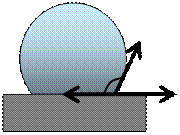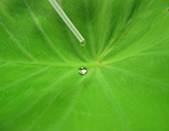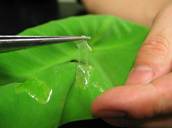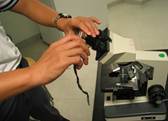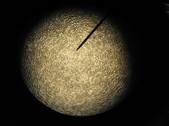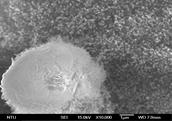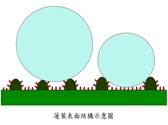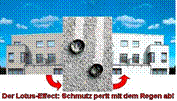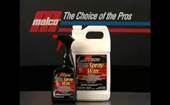Asia-Pacific Forum
on Science Learning and Teaching, Volume 12, Issue 2, Article 12 (Dec., 2011) |
Senior high school teacher’s nanotechnology curriculum design
Senior high school teachers introduce nanotechnology phenomenon and nanotechnology technology products of daily life to students, and then extend the nanotechnology conception from science teaching materials which are mentioned in some science textbooks. In the end, students sum up what they have learned and put these nanotechnology products science concepts or principles in order. For example, Lotus effect curriculum was designed as Figure 1.
- A lotus leaf can have a contact angle which is close to 90 degrees, making it hydrophobic, and extremely hydrophobic with a contact angle larger than 140 degrees (Figure 1a).
- Spread glue on the lotus leaf surface to form a thin membrane (Figure 1b).
- Use the microscope to take a micro-observation and found out that lotus leaf surface is covered with waxy crystals (Figure 1c).
- Use the scanning electron microscope (SEM) to take a micro-observation and found that lotus leaf surface has a fine structure. Air can be trapped in fine structures, and reduced the contact area between the water droplet and solid surface (Figure 1d).
- Dirt particles are picked up by water droplets due to a complex micro- and nanoscopic architecture of the surface, which minimizes adhesion (Figure 1e).
1a
1a
1b
1c
1c
1d
1d
www.lotusan.de/lotusan/_01_home/index.jsp1e
www.youtube.com/watch?v=rAif7o8pc381e
According to the senior high school nanotechnology curriculum design, Table 1 shows the extended science teaching materials from the original senior high school science lesson, and compares with the nanotechnology curriculum, science concept or principle exposition.
Table 1. Senior high school science extended lesson and nanotechnology curriculum design exposition
Chemicals I, II:
Materials in daily life5-3 Nano-tech materialsPhysical III, IV:
Surface tension11-4 Contact angleChemicals I, II:
Chemical batteries4-4 Redox reactionPhysical V, VI:
Light wave3-2 Diffraction and double-slit interfere experimentChemicals I, II:
Materials in daily life5-2 Clothing materials and chemistryFrom Table 1, we can find that senior high school teachers wish to bring out the nanotechnology science conception from science teaching materials that are relative to the ordinary lesson or extend from teaching materials, for example, when talking about the contact angle of surface tension, teachers let senior high school students measure the contact angle of lotus microvilli and water droplets. Students found that the angles are greater than 140 degrees, which can improve the water droplets are arising by microvilli and emerging from hydrophobic. So, they observe water and dirt that can’t stick on it, but they can resist stains and drainage.
Senior high school student’s nanotechnology-related conception development
We receive 453 valid nanotechnology problems for situational questionnaire answers; the questionnaire’s recovery is 90.1%. We gather students’ nanotechnology problem for situational questionnaire answers and analyze the correctness, alternative conception and the frequency of the alternative conception, which arrange as Table 2 (nanotechnology phenomenon ) and Table 3 (nanotechnology technology products of daily life).
Table 2. Classify and analyze NPSQ answers of nanotechnology phenomenon
Main alternative conception “Guessing pattern”
(Percentage, Person)Alternative conception “Cognitive incorrect pattern”
(Percentage, Person)The villus on the science surface has smaller volume of water droplets, which prevent the water from penetrating
(23.39%, 106 people)The density of the villus will let the water not attach the surface and format into water droplets
(22.97%, 104 people)The valve bristle on gecko’s toe has a barbed that can increase the adsorption (22.08%, 100 people)
The older living beings will teach younger ones to learn how to identify directions
(21.41%, 97 people)Because organisms have magnetic particles in their bodies
(21.63%, 98 people)Magnetic particles are able to identify the directions from magnetic effects
(24.28%, 110 people)Because the angle of the lights cames in differently
(22.30%, 101 people)The nano-size photocatalyst can reflect different colors
(26.27%, 119 people)The nano-size photocatalyst has different angles that can reflect different colors of light
(24.28%, 110 people)The cilium in moth’s eyes is black
(21.63%, 98 people)Moth’s eyes have cilium row tighter which can absorb lots of colors
(24.39%, 105 people)The nano cilium on moth’s eyes can’t reflect light
(22.95%, 104 people)Table 2 shows that after senior high school students learn nanotechnology phenomenon curriculum, around 20% to 25% can understand the science principle of nanotechnology phenomenon, but still can’t answer the questionnaires completely. Most of the students can comprehend the lotus effect, because high school teachers tend to use pictures to explain nano-tech phenomenon, and do the lotus effect experiment to make students understand the lotus effect better. High school teachers consider that bring the nano-tech curriculum in the normal science lesson can extend students’ learning, but would also cause lots of time pressures to the teachers. Some of the teachers conduct a science nano-tech camp and use a tematic teaching method to teach students. The lessons focus on a specific nano phenomenon like “nano photocatalyst”. Teacher introduces nano photocatalyst and observes the phenomenon by experiment, then shifts to introduce and analyze the nano-tech product. These teaching methods can give more clearly conceptions, but the disadvantage is that it only tells few of the nano-tech phenomenons, but not the entire nano-tech phenomenon. There are 60 senior high school students who attended the nano-tech science camp. On average, half of the students have incomplete nano-tech concepts, a quarter of students use the experience in daily life to guess the answers, the rest of them have wrong nano-tech cognitions. Some of them have alternative conceptions which are impossible to change, for example, Euploea butterfly will produce blue-violet color after shining the sun. Watching the phenomenon, students think that the nano-size nano photocatalyst on butterfly scales will reflex different colors and let us see.
Table 3. Classify and analyze NPSQ answers of nanotechnology technology products of daily life
Main alternative conception
“Guessing pattern”(Percentage, Person)Alternative conception
“Cognitive incorrect pattern”(Percentage, Person)Cause the mould can’t get into TiO2 Nano Photocatalyst, which keeps the mould outside and burns to death.
(28.47%, 129 people)Anti-bacterial effect resulting because of the chemical reaction
(25.52%, 116 people)Nano Car Spray can have decontamination effect after lighting
(23.39% , 106 people)Nano Car Spray is hydrophobic
(25.16%, 114 people)Nano-target anti-cancer drugs have nano-magnet
(21.63%, 98 people)Chemical properties of Nano-target anti-cancer drugs will directly attack cancer cells
(21.63%, 98 people)Nano-target anti-cancer drugs are attracted to cancer organ
(19.86%, 90 people)Reduce the size of object to increase the surface area of storage capacity
(23.39%, 106 people)Application of compression principles in order to increase memory capacity
(22.97%, 104 people)Reduce the volume of stored materials to increase the memory capacity
(17.89%, 81 people)Nano-sports shirt has big nano-holes and it easily can ventilate
(28.47%, 129 people)Nano-sports shirt can exude perspiration easily
(23.39%, 106 people)Nano-sports shirt has small nano-holes and it can ventilate easily
(23.40%, 106 people)From Table 3, we can see that senior high school students can’t express a complete answer even after learning nanotechnology technology products curriculum. Around 17.89~27.59% of students can just tell simple nano-science principle which we classify it as “Cognitive incomplete pattern”, examples like TiO2 nano photocatalyst can be antibacterial because of TiO2 light reaction will produce OH radical, and kill germs. Others, around 21.63~28.47% of students who don’t know the answers but guess through their life experiences, which we classify it as “Guessing pattern”, belonging to alternative conception, example like Nano-target anti-cancer drugs can attack cancer cells without harming the normal ones because Nano-target anti-cancer drugs has nano-magnet. Around 21.63~25.52% of students have alternative conception which are inconsistent with scientifically acceptable ideas, which we classify it as “Cognitive incorrect pattern”, example like TiO2 nano photocatalyst can be anti-bacterial effect resulting because of chemical reaction.
Scientists predicted the microcosmic world will have the most shocking evolution. Recently, US, Japan, Europe, Korea and even China have invested large founds in the national nanotechnology curriculum design (Lee & Tang, 2006). The focus of the K-12 Nanotechnology Program was to provide teachers information about nanotechnology and to develop materials to inspire students to learn about advanced technology. At the same time, the Five Higher Education Regional Centers of NHRD Program, developing Nanotechnology human resources in higher education and undertaking crucial tasks of personnel training (Taiwan Ministry of Education, 2009). Tasks included establishing Nanotechnology interdisciplinary curriculum programs, conducting equipment operation and training, hosting conferences and contests, and setting up international exchange programs (Wu, 2007). To apply nanotechnology concepts in teaching plans, school is the best place to strengthen citizens to understand nanotechnology knowledge through curriculum. We must apply a series of education plans to improve senior high school students learning nanotechnology curriculum.
Why do senior high school teachers design the nanotechnology curriculum in senior high school into the phenomenon-mechanism structure? Because they find the students are interested in phenomenon of nanotechnology, like lotus effect, and the students want to know what makes it hydrophobic. Finally, they know nano car spray is made by using hydrophobic principle of lotus effect and is able to resist stains and let water or dust can not mount up on it. Why the senior high school students couldn’t understand nanotechnology complementally? Interviewing senior high school teachers, they think nanotechnology curriculum is an informal curriculum; using camp activities time to teach, students might think it’s nothing to do with final examination or college entrance examination, which causes the result that student do neither review or be willing to strengthen the knowledge.

